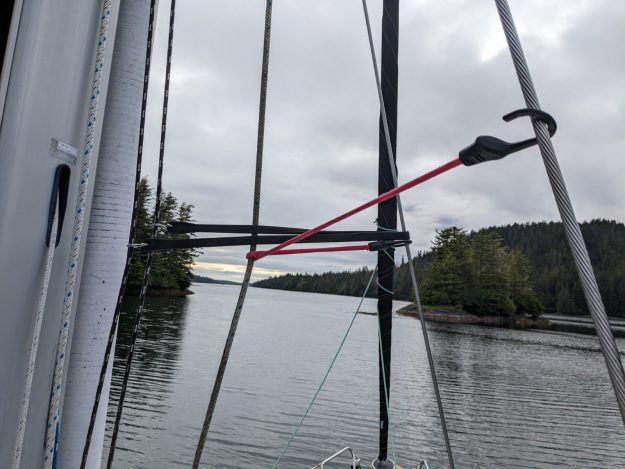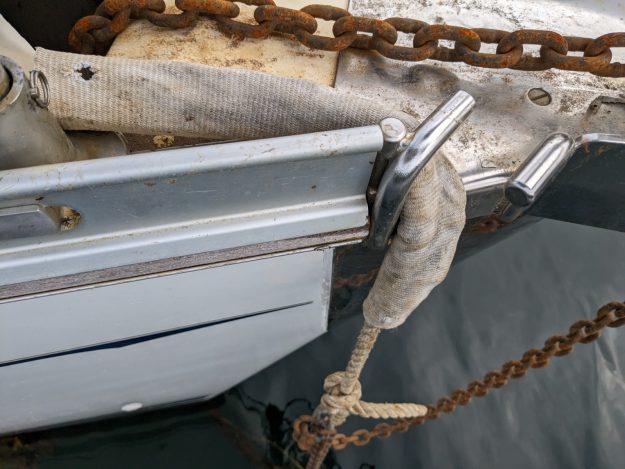One of my favorite things about cruising is the silence. True silence is rarely experienced in normal life – even in a quiet marina or town, there’s always background noise of distant cars, machinery, or appliances. On the water in a wilderness location, we sometimes find silence so deep that your ears strain just to find something. The call of a bird, or the wind in the trees. But in between there’s nothing. The sound of silence.
“The world is full of magic things, patiently waiting for our senses to grow sharper.” ~ WB Yeats
The quiet resets the auditory senses and after cruising for a while we start picking up dozens of subtle sounds we normally wouldn’t notice – specific bird calls, running water from a creek or waterfall, the THUMP THUMP THUMP of a humpback fin slapping miles away, the KER-PLUNK splash of a salmon, the nasally exhalation of a sea lion. Even the sound of a herring ball flashing is something we’ll always recognize now.
One thing non-boaters might find surprising is a sailboat is actually quite noisy at times – wind at anchor can make it sound like you’re in a hurricane, if you don’t do the right things to quiet the noises. On our second boat we applied many of the same noise control techniques we used on our first boat, and also had to invent a few new ones.

Scenery Cove, Thomas Bay AK
Some may not care about noise mitigation so much, saying the lapping sounds of the waves are a natural part of boating, or rocking and rolling lulls them to sleep. For me though, tuning out extraneous noise is important. Using earplugs at night, as some boaters do, tunes out your situational awareness. Sound is sometimes the first alert of something amiss – anchor dragging, bumping into something (logs, mooring balls, etc) or rising winds that might merit an anchor watch.

Jeanneau 43DS layout

Rig: Mast and Halyards
A sailboat rig is probably the biggest contributor to noise. Motorboats don’t have a 50-60′ aluminum pole above their deck, with many lines (mostly halyards) attached to it.
The standard first step for halyards is to tension them so they don’t slap against the mast. This typically isn’t sufficient, or only for light winds.
We use bungie cords (I’m a fan of these rubber bungie cords [Amazon] because they’re heavy duty and will last a while) to further pull the halyards away from the mast and give tension in a second direction. This reduces harmonic vibration that happens in certain wind conditions (especially wind on the beam, such as on dock or in high current anchorages).

For winter mode when we’ll be on dock a long time, we run some halyards forward to the bow area. This guarantees they won’t slap against the mast and eliminates chafe points that might be caused by bungie snubbers or rubbing on shrouds (rigging).
Even once you’ve eliminated halyard noise, the mast and rigging itself can create wind noise. There’s not much that can be done about this. When wind gets to a certain level, we have a strange humming sound that comes from our mast (which is deck-stepped).
Anchor: Snubber & Chain
At anchor, the snubber and cleat it’s tied to can be a source of noise. We have a pretty simple snubber system (not a bridle) and it’s important to have a chafe guard on the snubber. In higher winds we extend the snubber length which will give more stretch to absorb wind gusts. If you don’t have this stretch, the snubber may squeak more and the deck cleat may creak as it transfers load to the fiberglass deck.

(Yes, our chain is due for regalvanizing or replacement already!)
In typical light winds, the chain will hang nearly straight down and we keep the snubber short because otherwise the chain will rub against our bow or make noise rubbing against the snubber itself.
At dock, snubbers might be needed for your dock lines to reduce the snapping sound and shock loading if wakes or wind on the beam are bouncing your boat relative to the dock. A line snubber or “shockle” like these can help with that:
Hull and Deck
Anything banging against a boat hull can make a loud percussive sound. Loose canvas or a fender can make a repeated rhythmic drumming. Since sailboat hulls often sheer outwards to the toerail, fenders hung from the lifelines may be 2-3″ away from the hull. In windy or rolly conditions, some of our fenders swing back into the hull, making a tap-tap-tap sound all night long. Usually I can fiddle with their position to stop this. But some boat owners have fender covers – primarily to protect the hull from fender rub marks – but I think these would also dampen the noise of a fender tapping against the hull. We don’t have fender covers but might consider them.
We have a full cockpit enclosure, which is great, but we found in wind the side panel zippers can tap against the cockpit gelcoat making an annoying noise. So I found simply ziptieing a piece of foam onto them solved that problem.

With our new boat the biggest surprise was the stern sugar scoop style swim step can make loud booming sounds in certain conditions. The first time we were anchored outside Port Townsend a speedboat passed by our stern sending a wave at it, and a minute later we were surprised to hear explosive booming sounds from the stern – as the flat hull shape pounded on the water surface.
Fortunately wakes are short-lived, but tide rips or wind waves on the stern created quieter but very repetitive slapping noises on the hull, all night long, right near where we sleep. In Alaska, WA and BC many anchorages have significant current, which means wind waves aren’t always from the bow – we often get waves from the side or even the stern. In marinas with wind waves we also may be stern towards them.

The stern diaper below our sugar scoop style swim step where wavelets can create a loud booming in the aft berth.
For this problem we invented the stern diaper – a closed cell foam camping pad connected by lines tied to the toerail. The closed cell foam is best because it doesn’t absorb water – other foams like typical yoga matts got water logged and heavy. It’s silly looking and primitive, but it works! I have plans to improve the design next year. There’s actually a company that used to sell a professional version of this, but they no longer respond to inquires (out of business?).
We don’t always need the stern diaper – rarely in Southeast Alaska, since the anchorages are so well protected – but used it more often in BC and WA where some anchorages had current or boat wakes that could hit the stern.
Conclusion
Besides the things I mentioned above, there are plenty of standard tidying up tasks to do upon arrival to an anchorage or marina – if wind is expected, anything loose needs to be secured so it doesn’t flog or blow away. It’s worth the effort though – quiet is one of the best aspects of living aboard a boat.

How’s that “diaper” rigged? That slap is one of the worst things about our boat. I have tried a a few things but nothing successfully.
Just a camping mat tied in a tube? What’s the blue thing? Just a “scratch guard”?
Been loving the images over on instagram. Envious is an understate
The blue thing is the camping mat (about 1/2″ thick by ~7′ x 2′). Just laid out flat, and acts as a damper for wave action. Thicker would be better but it’s hard to find rolls of closed cell foam (and industrial stuff is surprisingly expensive). The black pads at the end are garden kneeling pads because I felt the blue mat wasn’t long enough to cover the sides. It’s definitely a bit kludgy. Got all this at the Powell River hardware store while we were enroute to AK in the spring.